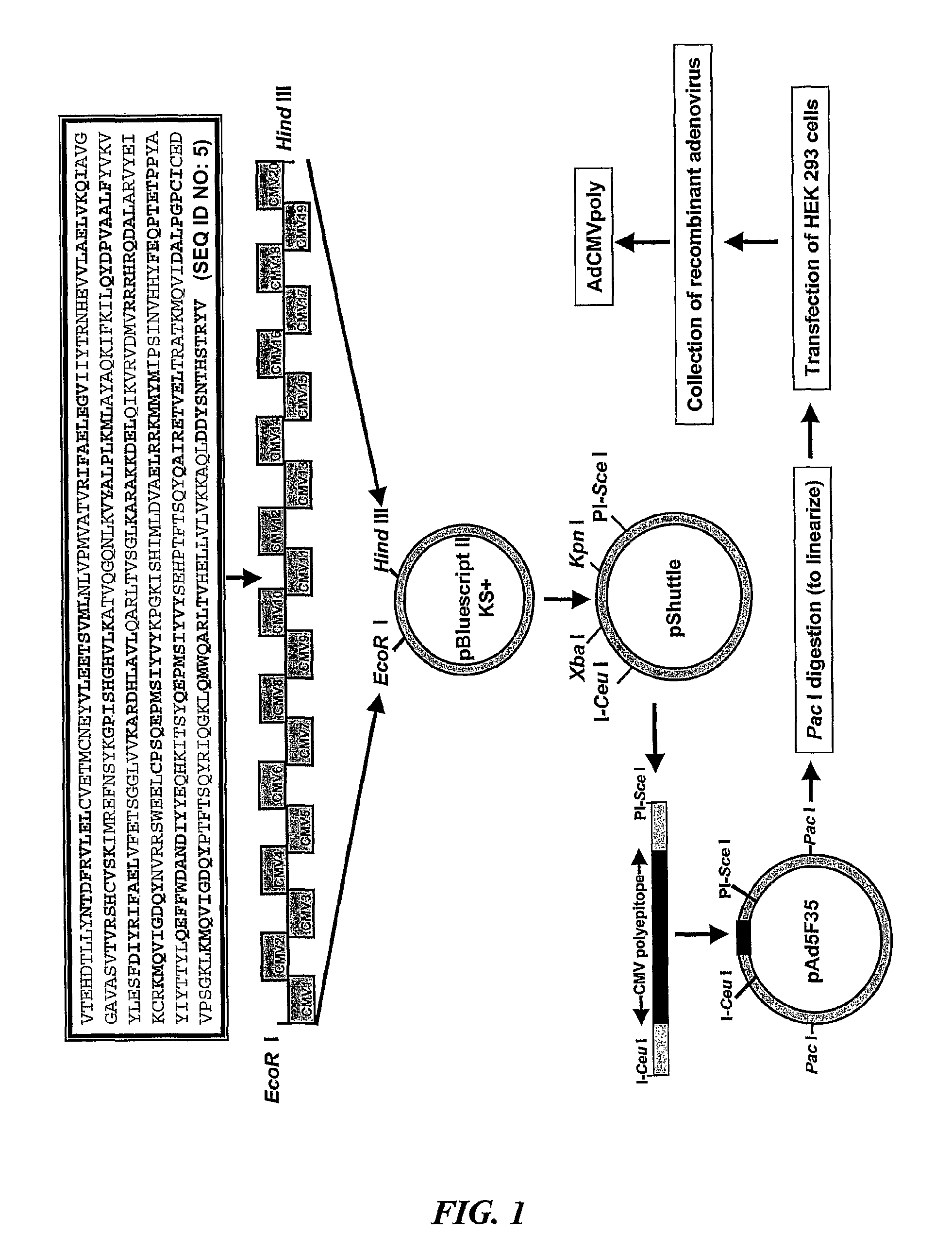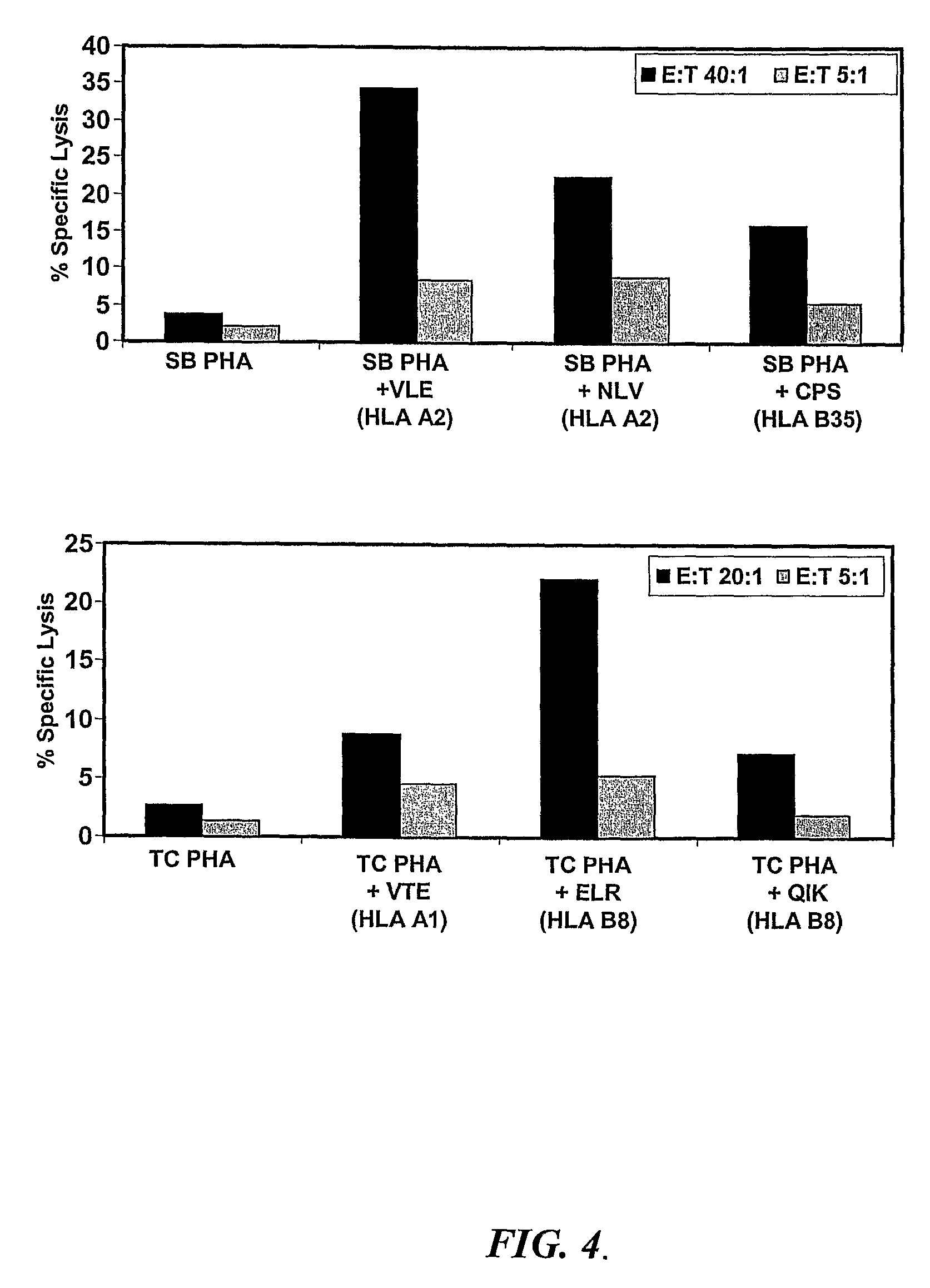Human cytomegalovirus immunotherapy
a technology of human cytomegalovirus and immunotherapy, which is applied in the field of immunotherapy of human cytomegalovirus, can solve the problems of affecting epitope presentation, limited protection of normal volunteers from vital challenge, and significant morbidity and mortality of hcmv infection
- Summary
- Abstract
- Description
- Claims
- Application Information
AI Technical Summary
Problems solved by technology
Method used
Image
Examples
example 1
HCMV Adenoviral Expression Constructs
Construction of a gB Vector with and without a Signal Sequence
[0204]HCMV encoded glycoprotein B (gB) was amplified from AD 169 virus stock by PCR using gene specific primers (pgBSIGF, pgBNOSIGF and pgBR) as shown in Table 5. The 5′ primer included a Bam H1 restriction site followed by a Kozak sequence and start codon. The 3′ primer included a Hind III restriction site. Two constructs were made, the first coding from the start methionine at position 2 to valine at position 700 thereby incorporating the signal sequence and the second coding from the alanine at position 31 to valine at position 700 with the deletion of the signal sequence. Following amplification, the DNA was gel purified, cloned into pBluescript 11 KS+ phagemid (Stratagene) and confirmed by DNA sequence analysis.
Recombinant CMV Polyepitope Construction
[0205]The epitopes have been combined using ‘Polytope’ technology as described in WO 03 / 000720. The amino acid sequence of the 38 co...
example 2
Antigenicity Studies with Recombinant Protein
Immunogenicity Testing of Recombinant Protein by ELISA
[0212]In the first set of experiments, the antigenicity of the recombinant protein using standard ELISA assay was tested. Ninety-six well micro-titre plates were coated with serially diluted (1:50 to 1:102,400) concentrated recombinant protein. These plates were then incubated with anti-gB monoclonal antibody (2F12, 1:8000, Abcam, UK) followed by incubation with secondary antibody (HRP-conjugated anti-mouse Ig, 1:10,000). After extensive washing, the TMB chromogen substrate was added and the OD was read by ELISA reader. Data in Table 3 and in FIG. 2 shows that the recombinant protein is efficiently recognized by the gB-specific monoclonal antibody.
[0213]In subsequent experiments, capture ELISA was used to assess the reactivity of the recombinant protein with gB-specific antibody. Ninety-six well micro-titre plates were coated with gB-specific antibody (1-M-12) at dilutions 1:500 (Well ...
example 3
Recombinant Protein Production in Mammalian Cells
Synthesis of tPA Signal Sequence
[0215]A tPA secretion signal sequence or ‘Sig’ was attached to the gB-CMV-polyepitope construct using the following method. Oligonucleotides TPAS-F and TPAS-R (see Table 3) incorporating a tPA signal sequence with kozak sequences were annealed, extended and the DNA fragment was inserted into pGEM-T (Promega, USA) vector. E. coli DH5α (Invitrogen, USA) was transformed using the ligated products and screened by PCR for the positive clones containing the inserted fragment. The positive colonies were amplified and the plasmids pGEM-tPA were extracted, purified, identified by restriction endonuclease cleavage and the inserted tPA DNA fragment was confirmed by DNA sequencing. The plasmid pGEM-tPA and mammalian expression vector pCEP4 (Invitrogen, USA) were cleaved by Kpn I and Nhe I restriction endonucleases and ligated using T4 DNA ligase. The transformation, amplification and plasmid purification were carri...
PUM
| Property | Measurement | Unit |
|---|---|---|
| temperature | aaaaa | aaaaa |
| nucleic acid | aaaaa | aaaaa |
| acid | aaaaa | aaaaa |
Abstract
Description
Claims
Application Information
 Login to View More
Login to View More - R&D
- Intellectual Property
- Life Sciences
- Materials
- Tech Scout
- Unparalleled Data Quality
- Higher Quality Content
- 60% Fewer Hallucinations
Browse by: Latest US Patents, China's latest patents, Technical Efficacy Thesaurus, Application Domain, Technology Topic, Popular Technical Reports.
© 2025 PatSnap. All rights reserved.Legal|Privacy policy|Modern Slavery Act Transparency Statement|Sitemap|About US| Contact US: help@patsnap.com



